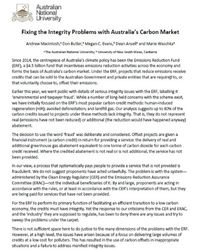
Since 2014, the centrepiece of Australia’s climate policy has been the Emissions Reduction Fund (ERF), a $4.5 billion fund that incentivises emissions reduction activities across the economy and forms the basis of Australia’s carbon market. Under the ERF, projects that reduce emissions receive credits that can be sold to the Australian Government and private entities that are required to, or that voluntarily choose to, offset their emissions.
Earlier this year, we went public with details of serious integrity issues with the ERF, labelling it ‘environmental and taxpayer fraud’. While a number of long-held concerns with the scheme exist, we have initially focused on the ERF’s most popular carbon credit methods: human-induced regeneration (HIR); avoided deforestation; and landfill gas. Our analysis suggests up to 80% of the carbon credits issued to projects under these methods lack integrity. That is, they do not represent real (emissions have not been reduced) or additional (the reduction would have happened anyway) abatement.